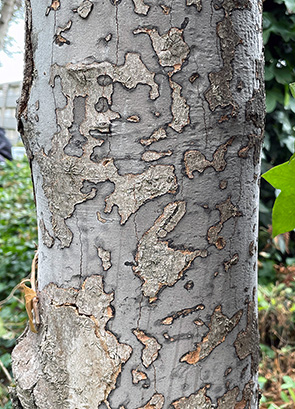Sooty bark disease (SBD) is an infection caused by a fungus (Cryptostroma corticale) that attacks maple trees in British Columbia (BC) – key host species include sycamore maple (Acer pseudoplatanus), Norway maple (A. platanoides), and bigleaf maple (A. macrophyllum).
The fungus is endemic to the Great Lakes region of North America but is considered an introduced disease in Europe. It was first detected in the Pacific Northwest region of the United States in 1968 but emerged there as a notable disease in 2020. It has been confirmed in British Columbia since 2022.
Host trees that experience drought and water stress, extreme heat, strong sunlight or unfavourable soil conditions cause the disease to spread faster and cause more damage. There is currently no control that exists for sooty bark disease.
Quick facts

Close-up of a tree trunk affected by sooty bark disease
Larger image [568 kb JPG]
- Sooty bark disease is found in Ontario and British Columbia
- Initial symptoms including leaf wilt and branch dieback, typically appear after a particularly hot and dry summer; tree death can occur within one to three years of symptom onset
- The fungus creates cankers that cause bark to crack and detach from the wood, with patches of white to dark brown or black spores appearing beneath the bark (see image)
- The fungus was first reported in Ontario in 1889, but mortality of maple was first recorded in 1945 in Europe
- Foresters and millworkers repeatedly exposed to a high concentration of spores may be at risk of developing hypersensitivity pneumonitis, or ‘maple-bark disease’
- Since the 1980s, the fungus has spread throughout urban and natural forests in Europe
- Several other diseases can be confused with sooty bark disease; if dark discolouration only occurs on the bark surface and not beneath detached bark pieces, it is not sooty bark disease.
Impacts
Loose masses of spores are produced beneath a tree’s bark once infection sets in, and the spores can easily disperse in the air and land on other potential hosts if disturbed. Once a tree is infected, it is difficult to halt the spread of the disease. As a result, sooty bark disease continues to spread quickly and affect forests in western Canada.
- The fungus easily spreads from one tree to another by wind dispersal.
- Reduced crown vigour and shortening of twigs are the first symptoms of an infection in maples.
- During the growing season, crown defoliation or wilting and curling of leaves can occur.
- Crown dieback or self-pruning of lower branches occur over time, and epicormic shoots develop near the base of the stressed tree.
- Sticky, dark-coloured fluid may be seen from the tree’s trunk or from pruning wounds in the spring and summer.
- Bark may appear raised with elongated blister-like growth running vertically along the stem and branches.
- The pathogen penetrates through wounds and natural openings (e.g., bark fissures, lenticels).
- As the infection progresses, the colour of the fungal spore masses changes from grayish white to dark brown.
Scientific research
Scientists have identified strategies to promote the survival of maple trees.
- Diversify species and strata in parks and forests by incorporating herbaceous and shrubby plants in maple stands.
- Give preference to maple trees growing beneath the forest canopy among other species.
- Limit soil compaction around maples in parks by installing setbacks, grass strips, flower beds, etc.
- Till soil to promote water retention, soil aeration, etc.
In a forest stand or managed woodlot, infected trees should be removed as quickly as possible to limit the spread of the disease.
- Remove trees in the winter or during humid weather to limit spore dispersal.
- Remove trees that are dead or decaying to mitigate safety risks associated with limb or whole-tree failure.
- High-value trees that are severely infected may be conserved by pruning the affected branches and cutting off trunk cankers.
Working collaboratively to develop solutions
Canadian Forest Service (CFS ) scientists are collaborating with the government of British Columbia (BC Ministry of Forests), municipalities and urban forestry professionals to address questions related to the diagnosis, distribution, spread, epidemiology, and host range of C. corticale and to define best management practices and control measures. The CFS is also advising public health partners (BC Centre for Disease Control and BC Health), who will provide recommendations to the public and to forestry workers.
CFS scientists are also developing innovative diagnostic solutions to improve the surveillance program of sooty bark disease. They are currently working on rapid ‘point-of-care’ diagnostic tests that accelerate the identification of new cases of sooty bark disease in the field and can be used in community science programs.
More information on sooty bark disease
Members of the public are encouraged to share observations on trees of concern directly to SBD Inquiries .